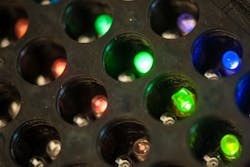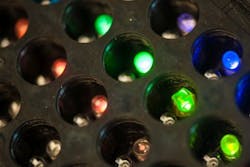Newly developed open-source optogenetics platform expands technique's reach
Researchers at Rice University (Houston, TX) have developed a low-cost optogenetics (a technique that involves genetically modifying cells with light-sensing molecules so that light can be used to turn genes and other cellular processes on or off) hardware platform that biologists who have little or no training in engineering or software design can use to incorporate optogenetics testing in their labs.
Related: Open-source technology enables closed-loop optogenetics
The Light Plate Apparatus (LPA)—which was created in the lab of Jeffrey Tabor, assistant professor of bioengineering—uses open-source hardware and software. The apparatus can deliver two independent light signals to each well in a standard 24-well plate, and has sockets that accept LEDs of wavelengths ranging from blue to far red (with the ability to swap out LEDs easily). It also features a low-cost microcontroller with an SD card reader, drivers capable of producing more than 4000 levels of light intensity, and millisecond time control. Total component costs for the LPA are less than $400 ($150 for labs with a 3D printer), and each unit can be assembled and calibrated by a nonexpert in one day.
With the goal of bringing optogenetics to any researcher interested in using it, Tabor and his students found ways to make most of the LPA's parts with 3D printers, and also created software called Iris that uses simple buttons and pull-down menus to allow researchers to program the instrument for a wide range of experiments.
Optogenetics' most notable successes have come in neuroscience following the invention of brain-implantable optical neuro interfaces, which have explored the cells and mechanisms associated with aggression, parenting, drug addiction, mating, same-sex attraction, anxiety, obsessive-compulsive disorders, and more. Karl Gerhardt, who works in Tabor's lab, explains that everyone has been developing the biological tools to do optogenetics (the light-sensing proteins, gene-expression systems, and protein interactions) in neuroscience, but no one has really developed good hardware that makes it easy to use those tools in applications beyond neuroscience.
To demonstrate the broad applicability of LPA, Tabor, Gerhardt, and their co-authors used the system to perform a series of optogenetics tests on a diverse set of model organisms, including gut bacteria, yeast, mammalian cells, and photosynthetic cyanobacteria.
To simplify the process for getting started with LPA, Tabor and Gerhardt have published all the software, design files, and specifications for the system on GitHub, a site that caters to the do-it-yourself community by making it easy to create, share, and distinguish different versions of software and files for open-source platforms like LPA.
Full details of the work appear in the journal Scientific Reports; for more information, please visit http://dx.doi.org/10.1038/srep35363.


